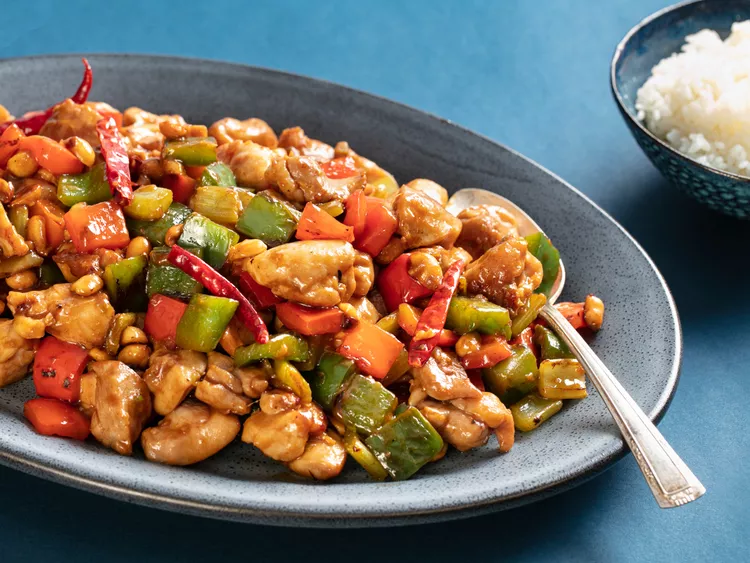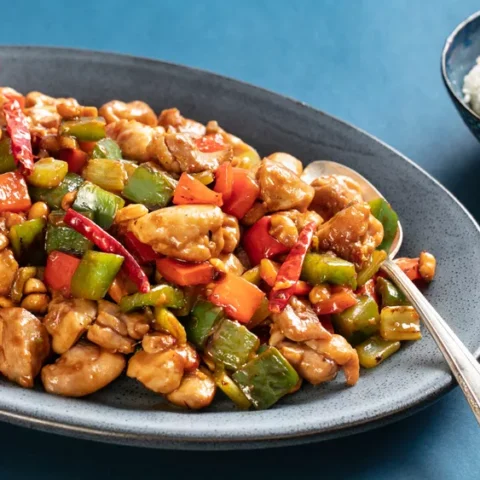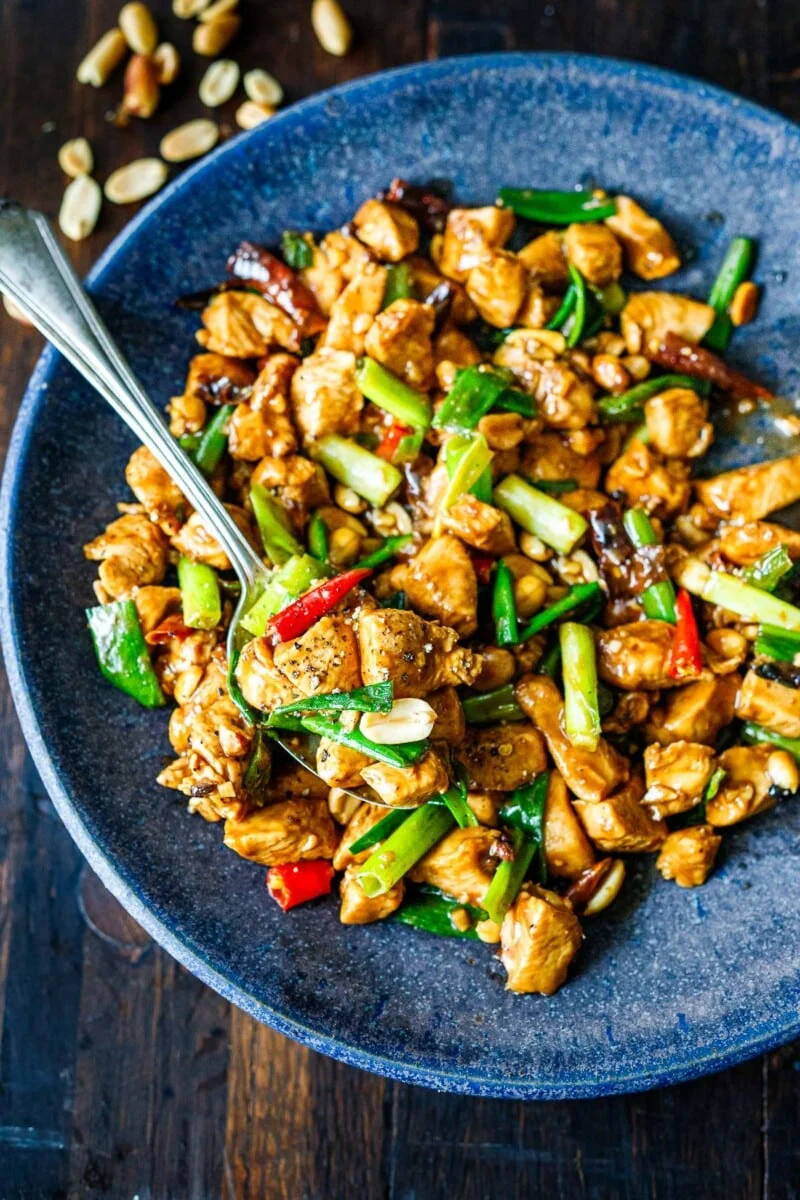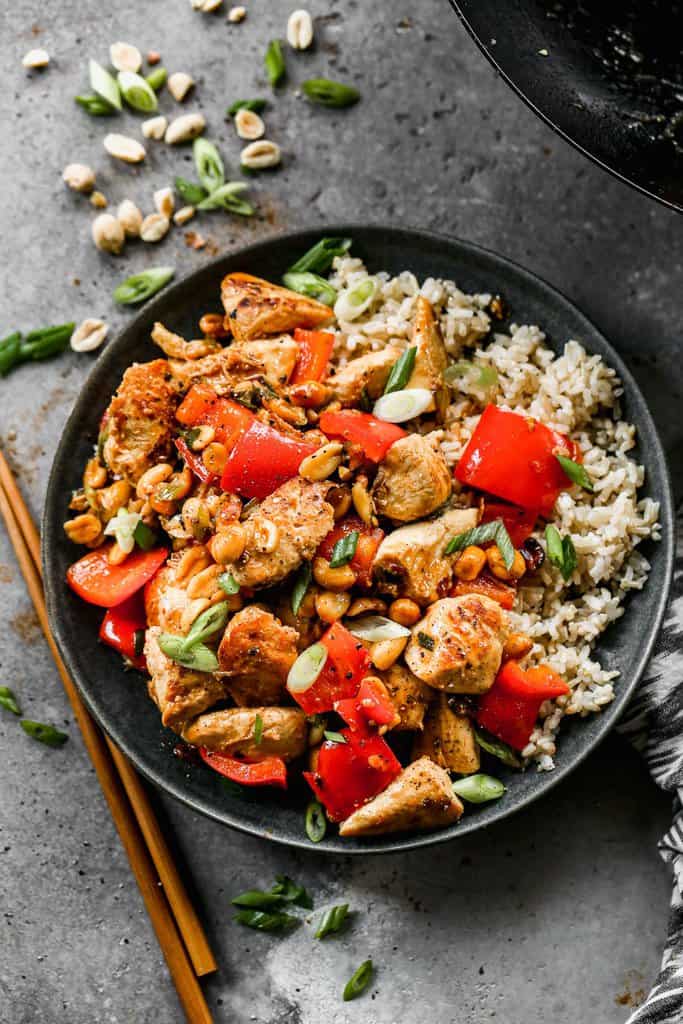If you’re a fan of Chinese takeout, then Kung Pao Chicken is likely at the top of your list. This dish perfectly balances tender chicken, crunchy peanuts, and vibrant vegetables, all coated in a bold, savory sauce that boasts a delightful sweet-sour twist and a hint of heat from Sichuan peppercorns.
While the version we enjoy today is a slightly westernized interpretation of a traditional Sichuan recipe, its irresistible flavors make it a quick and satisfying choice for an easy weeknight meal. In just 30 minutes, you can recreate this beloved classic in the comfort of your own kitchen, satisfying those cravings without the need for takeout. Dive in as we explore how to make this mouthwatering dish from scratch!
Historical Background
Kung Pao Chicken, known as “Gong Bao Ji Ding” in Mandarin, has a rich history dating back to the Qing Dynasty. The dish is named after Ding Baozhen, a Sichuan governor known for his love of food. The original recipe featured diced chicken, peanuts, and various vegetables, tainted with an intense flavor profile achieved through the use of Sichuan peppercorns.
Over the years, Kung Pao Chicken has evolved, with different regions of China adding their own culinary twists. Its popularity has also expanded beyond borders, leading to adaptations that cater to local tastes.

Cultural Significance
Kung Pao Chicken is not just a dish; it holds cultural significance in Chinese traditions. It is often served during festivals, family gatherings, and gatherings with friends. The dish symbolizes prosperity and good fortune, making it a popular choice during celebratory meals.
In Western contexts, Kung Pao Chicken has become synonymous with Chinese American cuisine. Its appeal lies in being both accessible and delightful, making it a popular choice among diners unfamiliar with traditional Chinese dishes.
Nutritional Value
Kung Pao Chicken is not only flavorful but can also be nutritious. The inclusion of chicken provides a good source of protein, vital for muscle building and repair. The peanuts offer healthy fats and protein, while the vegetables contribute vitamins, minerals, and dietary fiber.
However, it is essential to be mindful of portion sizes and the overall caloric intake, especially when dining at restaurants where the dish is often richer due to added sugars and oils.
Variations Across Cultures
Different regions and cultures have developed their own variations of Kung Pao Chicken, showcasing the versatility of the dish.
In the United States, it often features a sweeter sauce and may include a broader array of vegetables, catering to local tastes. Some adaptations use cashews instead of peanuts, while others may substitute chicken with tofu or shrimp for a different protein source.
In Thailand, a similar dish known as “Gai Pad Med Mamuang” incorporates Thai flavors and might use different herbs and spices to enhance its flavor profile.
Cooking Techniques
The preparation of Kung Pao Chicken involves techniques that enhance its flavor. The traditional method includes stir-frying the ingredients over high heat, allowing for rapid cooking that keeps the chicken tender and the vegetables crisp.
Marination is another crucial step; the chicken is often marinated beforehand to absorb flavors. This process, combined with high-heat cooking, helps create the characteristic aroma and taste that each bite offers.

Kung Pao Chicken
Ingredients
- **For the Chicken:
- 1 1/2 pounds (680 g) boneless skinless chicken thighs, cut into 3/4-inch chunks (see note)
- 1 teaspoon (5 ml) dark soy sauce
- 1 teaspoon (5 ml) Shaoxing wine (see note)
- 1/2 teaspoon sugar
- 1/2 teaspoon toasted sesame oil
- 1/2 teaspoon cornstarch
- 1/2 teaspoon Diamond Crystal kosher salt; for table salt use half as much by volume
- 1/4 teaspoon ground white pepper
- **For the Stir-Fry:
- 2 tablespoons (30 ml) homemade or store-bought low-sodium chicken stock
- 1 tablespoon (15 ml) dark soy sauce
- 1 tablespoon (15 ml) Shaoxing wine
- 1 tablespoon (15 ml) distilled white vinegar
- 1 tablespoon (15 g) sugar
- 2 teaspoons (5 g) cornstarch
- 1 teaspoon toasted (5 ml) sesame oil
- 3 tablespoons (45 ml) vegetable, peanut, or canola oil, divided
- 1 large red bell pepper, cut into 3/4-inch dice
- 1 large green bell pepper, cut into 3/4-inch dice
- 2 stalks celery, cut into 3/4-inch dice
- 1/2 cup (100 g) roasted peanuts
- 2 teaspoons (5 g) minced fresh garlic (about 2 medium cloves)
- 2 teaspoons (5 g) minced fresh ginger
- 1 scallion, white and light green parts only, finely minced
- 8 small dried red Chinese or Arbol chiles (see note)
Instructions
Begin by marinating the chicken.
- Combine chunks of dark-meat chicken with salt, sugar, white pepper, soy sauce, Shaoxing wine, oil, and cornstarch.
- Let it marinate for about 20 minutes to enhance flavor and moisture.
Heat a wok to a high temperature.
- Stir-fry the marinated chicken until it is lightly browned but still raw in the center.
- Transfer the chicken to a bowl and set aside.
Stir-fry the vegetables.
- Prepare red and green bell peppers and celery, each cut into equal-sized chunks.
- Cook the vegetables in batches to avoid overcrowding, allowing them to char slightly.
Add peanuts to the cooked vegetables.
- Use roasted peanuts for convenience, incorporating them into the pan after the vegetables are cooked.
Introduce aromatics into the stir-fry.
- Add minced garlic, ginger, and scallions to the wok.
- Toss briefly before adding a handful of dried red chiles for flavor.
Return the chicken to the wok for heating.
- Quickly mix the chicken with the vegetable and aromatic mixture.
Prepare the sauce.
- Pre-mix soy sauce, chicken broth, vinegar, sesame oil, sugar, and cornstarch in a bowl.
- Add the sauce to the wok, tossing until it thickens to coat the chicken and vegetables.
Serve the dish.
- Plate the kung pao chicken alongside steamed rice and enjoy.

At Villa Corona Mexican Grill, we’re passionate about sharing our love for authentic Mexican seafood dishes with food enthusiasts like you. Dive into our feed to discover mouthwatering photos and videos of our delectable ceviches, fish tacos, shrimp cocktails, and more. We’ll take you on a culinary journey through Mexican coastal cuisine’s vibrant flavors and rich traditions.
Get ready to tantalize your taste buds and embark on a flavorful adventure with us. Follow, like, and share to become part of the Villa Corona Mexican Grill family today! 🌊🍤🌶️ #MexicanSeafood #VillaCoronaMexicanGrill



